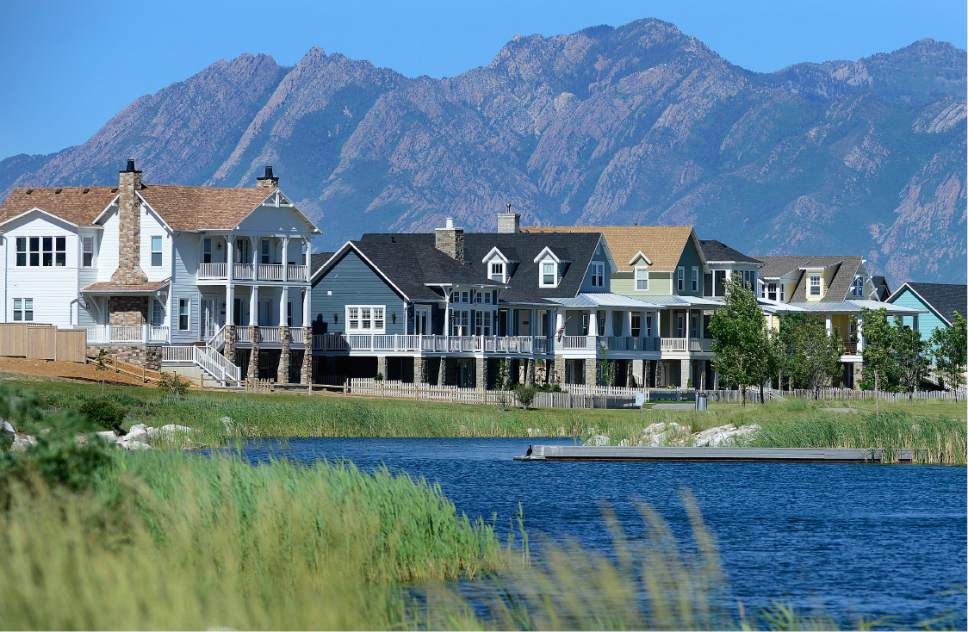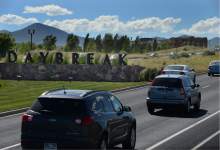This is an archived article that was published on sltrib.com in 2017, and information in the article may be outdated. It is provided only for personal research purposes and may not be reprinted.
South Jordan • More than two years after filing suit, a Daybreak homeowners association is fighting for compensation from builders and developers it says erected hundreds of town homes with "severe" construction defects from millions of dollars' worth of water damage in walls.
But builders argue that their work was good and that homeowners did not maintain properties well, leading to the damage.
The Daybreak Townhome 1 Owners' Association represents nearly 400 South Jordan families, according to a news release from the association sent before a Wednesday morning news conference. The group filed suit in 3rd District Court against six corporations more than two years ago. It also is suing several subsidiaries and individuals involved in constructing and managing the development.
The lawsuit identifies 102 buildings, near 10620 South and 4600 West, that the plaintiffs say are poorly constructed.
All units — constructed from 2005 to 2013 — have sustained damage, says a report published last month by J2 Building Consultants Inc. for the homeowners association, and the most competitive contracting bids estimate the repairs would cost about $23 million and take more than two years to complete, according to a bid summary from contractors that also was published last month.
The report contains hundreds of photos and descriptions detailing structural problems in walls, roofs, windows, doors and porches.
Defective installation of various components of the houses, the report says, allowed for water damage, such as cracked stucco and rotting trim, in sheathing, insulation, framing, and interior floors and drywall in the town homes.
But at least one builder named in the lawsuit, Holmes Homes Inc., has documentation of its own, which it says shows the company's high quality of work on the portion of units it constructed.
The company produced a news release Wednesday, stating that it "not only complied but also exceed industry construction standards." Holmes Homes hired a third party inspector, Quality Built, during construction to examine its units and take thousands of detailed photos throughout the process "to ensure quality."
After a few years, regular upkeep is necessary for any home, the release said.
"We are disappointed that this issue has escalated to this level, and it's unfortunate that we were not informed of these claims until litigation was implicated," wrote co-owners Spencer Holmes and Patrick Holmes, adding that the company "has always responded to all warranty claims."
"We pride ourselves on taking care of our customers and have always had an open line of communication with our homeowners," they said. "We take our legacy seriously and want our homeowners to be happy with their purchase."
At a second news conference Wednesday afternoon, a former and a current resident of the town homes in question testified that not every unit experienced structural problems. Cameron Jackson, marketing director for Daybreak Communities, said that while he hopes the problems are resolved, reports of unresponsive builders and shoddy workmanship "are not representative of what we've seen or what our experiences have been" with the development of 5,000 homes in the area over the past decade.
He cited a yearly survey of community members, which he said shows 92 percent of them would recommend their builder to friends.
One of the women at the afternoon conference, Terri Hawk, moved from the neighborhood in February after living there for seven years. Hawk never had problems with structural damage, she said, but she'd had a hard time getting the homeowners association to respond to requests for routine maintenance issues.
Wendi Bailey has lived in her town home for nearly 10 years, she said, and while she's heard of other people's homes having problems, her town house and those of her neighbors on either side don't appear to be poorly built or have any of the reported structural damage.
Nevertheless, in the past year, invoices show that the homeowners association has spent more than $113,000 on emergency repairs to units on a case-by-case basis.
Many of the people living in the houses are young families or retirees with fixed incomes and without extra money to fix all the problems with homes, said a news release from the homeowners association's attorneys. Bailey mentioned that homeowners association fees now are about $50 a month, but that they could rise by up to $700, at which point she couldn't afford to stay in the home she loves.
The lawsuit states that defendants did not advise the homeowners association of damage and turned over the town homes' management without properly disclosing financial and inspection needs.
Sean Gores, owner of Gores Construction Inc., has handled many of the calls for emergency repairs. Regardless of when the homes were built, "the building practices are the same," Gores said, paving the way for water damage as snow melts.
Daybreak Townhome 1 buildings, Gores said, aren't the only poorly built units in the area. He said he's been dealing with similar problems in Daybreak Carriages, Daybreak Eastlake and at other structures throughout the Salt Lake and Utah valleys.
It's unfair for residents to have to set up buckets in 10-year-old homes to catch water leaking from the ceiling, he said, or for mold to be growing in rotting walls of children's bedrooms.
"Homeowners are really frustrated that the contractors aren't stepping up to do something about it," Gores said. "Whether there's a lawsuit or not ... they have to fix their homes eventually."
Contractors in the area seem to be more schedule- and money-driven, rather than quality-driven, he said. "A lot of homeowners [are] going to lose their homes over this. It's really unfortunate."
Gores added that the way laws are written in Utah seems to swing in favor of contractors and doesn't protect homeowners. He encouraged homeowners in the area to contact legislators who can inspect the damage and change the law to hold builders accountable.
Homes should be built to last 100 years, Gores said, not 12.
Twitter: @mnoblenews







